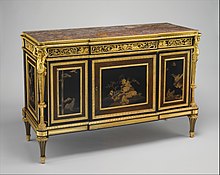Adam Weisweiler
Adam Weisweiler (born October 28, 1746 in Korschenbroich ; † June 15, 1820 in Paris ) is one of the most important cabinet makers and cabinet makers of the late 18th century.
His elegant furniture in the style of Louis-Seize , Consulat and Empire were already extremely sought-after collector's items during Weisweiler's lifetime and were traded at top prices. The Marchand-Mercier Dominique Daguerre delivered Weisweiler's furniture to various European courts such as for Carlton House to George IV , Prince of Wales . Typical of Weis hamlet handwriting furniture are mahogany - or ebony veneer , in addition to the usual fire-gilded bronze fittings additional applications from Porcelain de Sèvres , Japanese lacquer or pietra dura have. After his retirement, his son Jean Weisweiler continued the workshop until 1844.
Together with Jean-François Oeben , Martin Carlin , Jean-Henri Riesener , Bernard Molitor and David Roentgen , Weisweiler is one of the most famous cabinet makers of the second half of the 18th century and is in the tradition of the German-speaking cabinetmaker community in Paris.
Museums
Furniture from the hand of Adam Weisweiler has u. a. received in the following museums:
- The Wallace Collection , London
- The James A. de Rothschild Collection at Waddesdon Manor, Waddesdon, Buckinghamshire
- The Getty Foundation , Malibu, California
- Metropolitan Museum of Art
- Musée du Louvre , Paris
- Musée Nissim de Cammondo , Paris
- Musée des Arts décoratifs , Paris
literature
- Maurice Ségoura, Patricia Lemonnier: Weisweiler. Art Monelle Hayot, Paris 1983, ISBN 2-903824-03-7 .
- Alexander Pradère: The Art of French Furniture. Elders from Louis XIV to the Revolution (“Les ébénistes français de Louis XIV à la révolution”, 1990). Beck, Munich 1996, ISBN 3-406-34110-1 .
- Liesel Weissweiler (with Eva Weissweiler): Adam Weisweiler. A Parisian art furniture maker from the Lower Rhine Schelsen. In: Rheydter Jahrbuch für Geschichte, Kunst und Heimatkunde , Vol. 25 (2000), pp. 37–54, ISSN 0482-878X .
| personal data | |
|---|---|
| SURNAME | Weisweiler, Adam |
| BRIEF DESCRIPTION | German cabinet maker and cabinet maker |
| DATE OF BIRTH | October 28, 1746 |
| PLACE OF BIRTH | Korschenbroich |
| DATE OF DEATH | June 15, 1820 |
| Place of death | Paris |
